Open position: Employee (f/m/d) in science and teaching for the field of architecture (Material Library)
Tender Number: 1334/2025
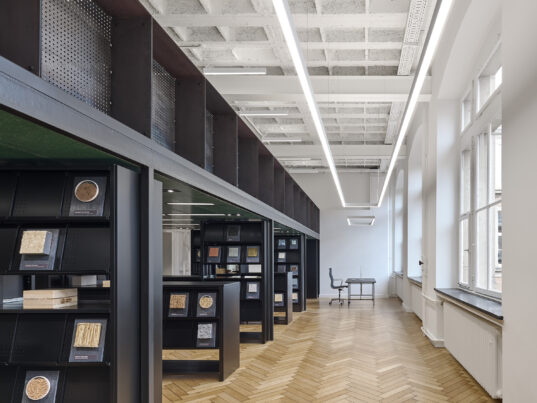
Organizational Unit: Institute IEB
Start Date: 1. February 2026
Scope of work: Part-time 50%
More information here.
Tender Number: 1334/2025

Organizational Unit: Institute IEB
Start Date: 1. February 2026
Scope of work: Part-time 50%
More information here.
“The KIT Material Library is part of a larger research project on sustainable and circular construction. It investigates how materials can be designed, used, and returned to closed cycles in the future. The focus is on building materials that are locally available or produced and can either be composted biologically or recycled technically without any loss of quality. The library sees itself as a repository of knowledge and a tool for training a generation of architects who design responsibly and with an eye to the future.”
BauNetz (2025). Materialwissen zum Anfassen: Die KIT Materialbibliothek. [online] BauNetz. https://www.baunetz-campus.de/news/materialwissen-zum-anfassen-die-kit-materialbibliothek-10099461 [abgerufen am 19.11.2025].
More about the Post on here on Baunetz Campus
In the interview of Regina Link for “lookKIT” with Sandra Böhm and Elena Boerman from the Professorship of Sustainable Construction at KIT they share insights into circular building practices. Their work centers on circular buildings that allow materials to be reused at the same quality level, reducing waste and conserving resources.
A key example is RoofKIT, a full-scale prototype of a rooftop extension developed by students. It demonstrates how modular design and natural materials like sea grass, hemp, and mushroom mycelium can be used effectively in construction. RoofKIT also serves as a communication tool with industry stakeholders, making circularity tangible.
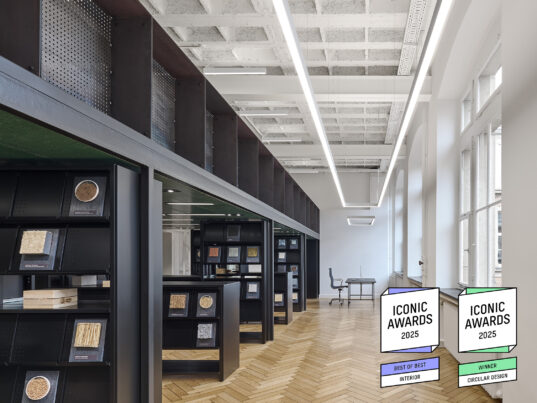
© Zooey Braun
The KIT Material Library has been honored in two categories of the Iconic Awards in August 2025: the Best of Best Interior category and the Circular Design category. The jury’s statement says: „The revitalised material library at the Karlsruhe Institute of Technology (KIT) serves as an analogue and digital knowledge repository for imparting knowledge on the subject of innovative building materials of the past, present and future. The project was realised by the Faculty of Architecture and the Professor of Sustainable Building at KIT, Dirk E-Hebel, in cooperation with STUDIO-MRA from Stuttgart. The newly arranged collection is accessible to students, interested members of the public and experts, who can also draw inspiration from the successful quality of a circular construction method. The interior is characterised not least by its exceptional clarity – it is minimalist, yet impressive and powerful.“
Team MycoLab (Nazanin Saeidi, Karlsruhe Institute of Technology (KIT), Germany) was selected as one of the top 5 finalists for the prestigious Evergreen Prize 2025, sponsored by HS Timber Group and organized by the Evergreen Privatstiftung. Our project, “From Waste to Resource – Advancing Circular Bio-Based Materials for the Construction Industry,” was recognized by a distinguished jury of timber experts for its innovative approach and impact. During an exhilarating day of live presentations at the Vienna City Hall on 26 May 2025, witnessed by over 900 attendees from more than 50 countries, Team MycoLab advanced to the top 3, showcasing the global potential of circular, bio-based solutions in construction.
Team Mycolab was competing with Team BranchUP (Maximilian Pramreiter, University of Natural Resources and Life Sciences, Vienna (BOKU), Austria), Team Hyperlignification (Emil Engelund Thybring, University of Copenhagen, Denmark), Team Transparent Wood (Yuanyuan Li, KTH Royal Institute of Technology, Sweden) and Team LignoVolt (Ingo Burgert, ETH Zürich, Switzerland).
The live presentations took place at the Vienna City Hall. Team MycoLab advanced to the top 3, showcasing the global potential of circular, bio-based solutions in construction.
For more information watch the video about the team and their presentation here.

In the podcast episode “Zeitfragen” broadcast on June 17, 2025, on Deutschlandfunk Kultur, hemp lime was discussed as a sustainable building material and alternative to concrete. Hemp as a building material offers advantages throughout its entire life cycle in terms of its environmental compatibility, for example with regard to the uncomplicated and pesticide-free cultivation of the raw material, or in terms of its excellent physical properties, such as its diffusion openness.
Sandra Böhm, along with other protagonists in the podcast, talks about the advantages of hemp as a building material. She particularly emphasizes the need for targeted use of materials and a new diversity of materials necessary for a sustainable construction industry.
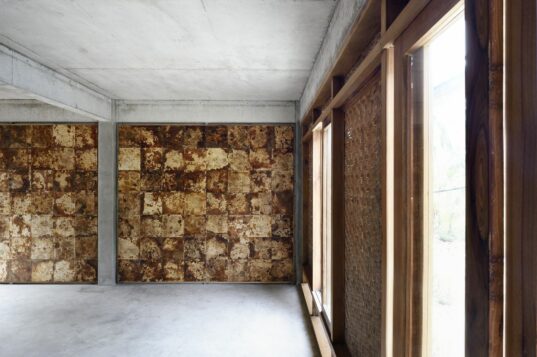
By combining wood and agricultural waste with mycelium as a natural binder, a sustainable material is created without the need for fresh wood or synthetic adhesives. This material offers density and stability comparable to OSB, MDF, and particle boards. It is suitable for furniture construction, drywall systems, and as a substitute for synthetic insulation materials.
A 1:1 demonstrator at KIT showcases NEWood as an interior wall system and furniture component. The circular room system serves as a quiet meeting space where students and staff can test the material. The goal is to achieve market readiness within two to four years.
Find out more about the project here or in the blog post below.
Research Project NEWood – Sustainable material innovation for the construction and furniture industry

Project representatives of all projects funded under the ‘Circular Construction – Climate Protection through Recycling Management’ programme © Baden-Württemberg Stiftung gGmbH
The Karlsruhe Institute of Technology (KIT), under the direction of Prof. Rebekka Volk (IIP), is working in close collaboration with the project leader Dr. Nazanin Saeidi from the research department of the Professorship of Sustainable Construction (IEB) to develop the innovative material ‘NEWood’, a 100% bio-based and circular material alternative with great potential for the construction and furniture industries. This material is produced exclusively from wood processing residues, agricultural waste and mushroom mycelium – completely without fossil raw materials. In the process, biogenic carbon is permanently bound, making an important contribution to climate protection.
The construction and operation of buildings and the creation of infrastructure are responsible for around 40% of global greenhouse gas emissions. At the same time, cities consume over 75% of the world’s resources and generate about half of the global waste. In this context, alternative and sustainable materials such as NEWood are becoming increasingly important in order to significantly reduce the emissions of material-intensive industries and promote the circular economy.
The project aims to develop 1:1 demonstrators that illustrate the versatility of NEWood for interior wall systems and furniture components. These demonstrators will be designed to meet the legal standards of the construction and furniture industries in order to enable the material to be launched on the market. In addition, the project includes a life cycle analysis, a cost analysis and a feasibility study for industrialisation. The results will be presented at trade fairs, at the KIT Department of Architecture and in the central library of the KIT in order to make the application possibilities and the potential of NEWood visible to the public.
The project is funded by the Baden-Württemberg Stiftung gGmbH and will run from July 2024 to June 2026. In addition to the KIT, partners such as König + Neurath AG and Fiber Engineering are involved in the development.
NEWood combines innovation and sustainability. With its ability to permanently bind biogenic carbon and replace fossil materials, this material can revolutionise the circular economy in the construction and furniture industries. At the same time, it makes a significant contribution to reducing greenhouse gas emissions and protecting the climate.

The KIT Material Library has been awarded the “Badischer Architektur Preis” (BDAP) in the Interior Design category for its innovative, circular concept. The renovation features materials that have already completed a life cycle, sourced from the so-called “urban mine”. All materials are sorted and installed without adhesives or silicones to maximize recyclability.

Manuel Rausch (STUDIO-MRA) was the lead architect of the Material Library. The design concept was developed in collaboration with the Material Library team, particularly the selection of materials for the interior was made with Professor Dirk E. Hebel, Sandra Böhm, Elena Boerman, and Thomas Kinsch.
With an extensive collection of building materials, the library offers students the chance to experience materials firsthand and integrate them into their design processes. The architectural redesign presents a bright, airy space with a gallery level that encourages interaction and exploration.
This material library serves as a knowledge repository for sustainable building materials, providing both analog and digital resources for research and education.

For more information, visit the BDAP website.
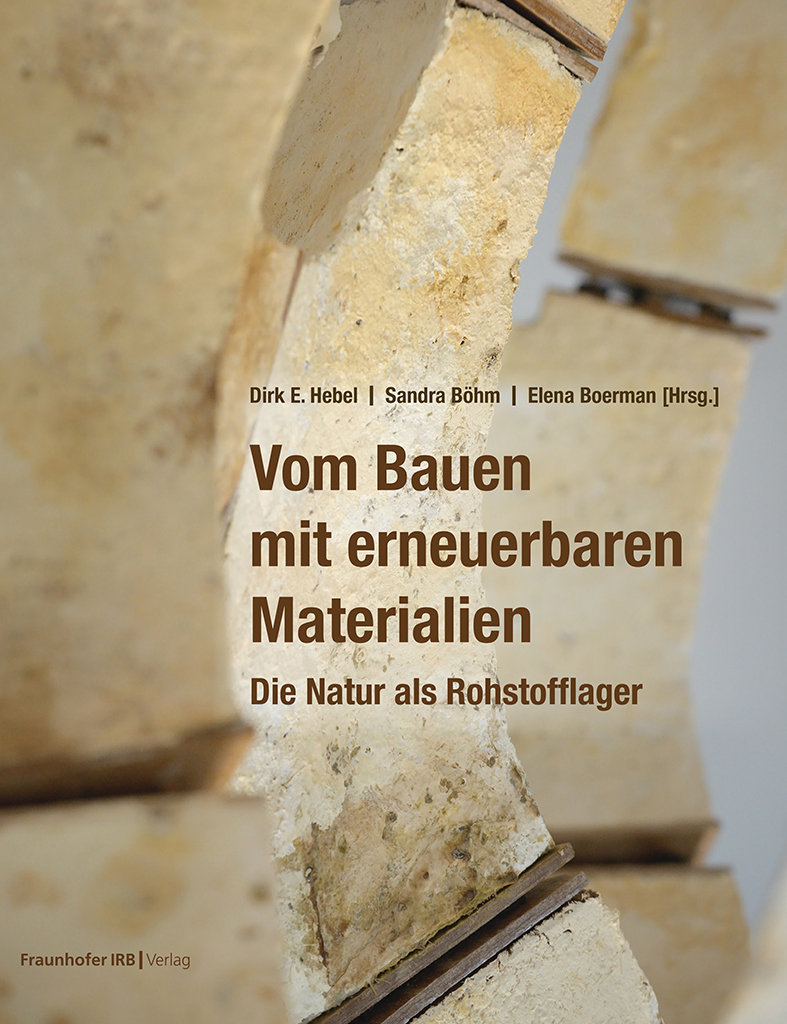
Building with renewables – our nature as material stock
Dirk E. Hebel, Sandra Böhm und Elena Boerman (Editors), Fraunhofer IRB Verlag, Stuttgart, 2024
With contributions from Hanaa Dahy, Moritz Dörstelmann, Alireza Javadian, Mitchell Joachim, Henk Jonkers, Andrea Klinge, Clemens Quirin, Eike Roswag-Klinge, Martin Rauch, Nazanin Saeidi, Michael Sailer und Werner Schmidt.
Designing our built environment in a socially, economically and ecologically fair way is a major social responsibility for all planners. How can we address the scarcity of resources in construction and achieve a completely circular economy? International experts from research and practice are addressing these important questions, with a particular focus on renewable and bio-based building materials. In addition to traditional building materials such as wood and clay, they also describe a variety of innovative bio-based materials and building products and consider their performance and availability. Their visions and ideas outline how biomaterials can be used in buildings and constructions. Project examples offer inspiration for your own planning and building. A collection of selected material examples illustrates the special aesthetics and value of components made from sown, grown and harvested resources. In order to preserve our livelihoods, much more focus must be placed on circular biological materials. The positive incentives and food for thought in this book show possible ways to build in consistence with our natural processes and systems.
Nazanin Saeidi in an interview with Maike Rubel and Patricia Leuchtenberger about the innovative manufacturing process and the advantages of NEWood as a recyclable alternative to wooden composite materials.
We are pleased to finally publish the entire documentation of the RoofKIT project. Many thanks to all project participants, sponsors, to the RoofKIT team and the film team around Pia Berchtold (piapiapia).
RoofKIT was one of 18 entries to the Solar Decathlon Europe 21-22, in which student teams from international colleges and universities each constructed a fully functional building prototype in Wuppertal in the summer of 2022, with which they competed in ten different architectural and structural engineering disciplines. With the RoofKIT project, the team from the Karlsruhe Institute of Technology won the Solar Decathlon Europe 21-22. In two and a half years of intensive interdisciplinary teamwork in teaching, research and practice, students and teachers addressed the issues of sustainable resource consumption, renewable energy generation and coexistence in the city of the future from an architectural perspective.
The building prototype is now located on KIT Campus Süd in Karlsruhe – we cordially invite you to register for a public RoofKIT tour here.
On Saturday, May 13, the KIT Campustag will take place again. All KIT faculties will present their study programs and offer great hands-on activities, experiments, guided tours and much more. In addition, there will be a stage on the forum, where a colorful live program will be offered. Various bands, science slam, theater groups, university groups, and many more will show what KIT has to offer besides studies.
The Faculty of Architecture at the Karlsruhe Institute of Technology also cordially invites you to its annual exhibition “Reinschauen”. From May 11 to 17, 2023, all professorships, workshops and studios will present works and projects from the past academic year and provide an insight into the range of teaching and research at the faculty. The program includes presentations, short lectures, taster lectures and guided tours.
The Professorship of Sustainable Construction presents its wide-ranging work in teaching, research, exhibitions, events and other projects in the foyer of the 1st floor. The RoofKIT project is also part of this exhibition.
The building prototype of RoofKIT, which has been located on the KIT South Campus since November 2022 (building 30.79, intersection Straße am Forum / Richard-Willstätter-Allee), will open its doors in the context of the Campus Day on May 13 from 1 pm. Team RoofKIT cordially invites you to talk about the project and to have a look at the building prototype.
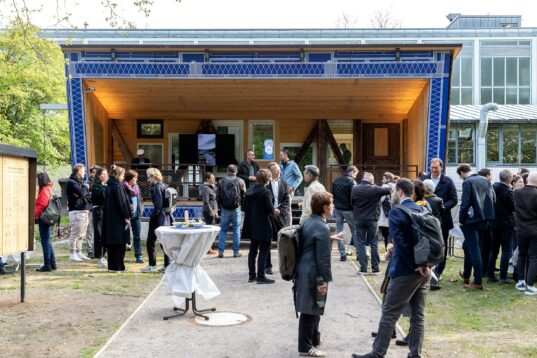
WHEN: Saturday, May 13, 2023 from 1PM
WHERE: RoofKIT (building 30.79), intersection Straße am Forum / Richard-Willstätter-Allee
RoofKIT was one of 18 entries to the Solar Decathlon Europe 21-22, in which student teams from international colleges and universities each constructed a fully functional building prototype in Wuppertal in the summer of 2022, with which they competed in ten different architectural and structural engineering disciplines. With the RoofKIT project, the team from the Karlsruhe Institute of Technology won the Solar Decathlon Europe 21-22. In two and a half years of intensive interdisciplinary teamwork in teaching, research and practice, students and teachers addressed the issues of sustainable resource consumption, renewable energy generation and coexistence in the city of the future from an architectural perspective.
The Environmental Foundation of Sparkasse Pforzheim Calw honors four projects with the Umweltpreis 2023. The presentation of the prizes, worth a total of 15,000 euros, took place on March 15, 2023 at the Sparkasse in Calw. The main prize of 7,500 euros was awarded to the team from the Karlsruhe Institute of Technology (KIT) for the “NEWood” project.
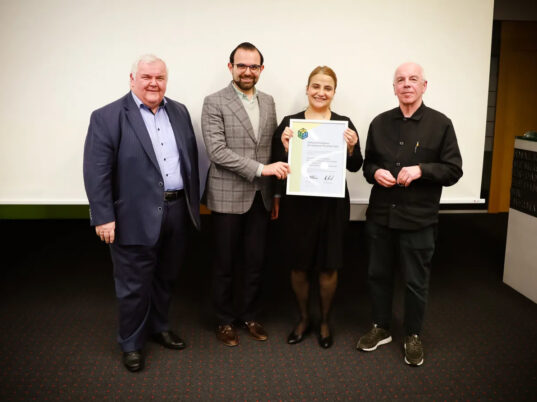
The NEWood project is about developing new bio-based, sustainable and renewable materials that can replace conventional wood products, such as particleboard. Most of the currently available wood-based products do not meet the principles of the circular economy. KIT researchers now aim to develop materials that can replace unsustainable wood products in the construction industry. Time is pressing, as forests are threatened by deforestation due to strong demand. In addition, the production of synthetic binders, which require wood products, results in CO2 emissions that accelerate climate change. From an ecological point of view, the pressure on forests should be reduced and industrial greenhouse gas emissions reduced.
The “NEWood” material developed by the KIT team belongs to a new class of biobased, resource-efficient and CO2-negative materials. It is produced exclusively from regionally available organic waste, including agricultural residues. As a sustainable and renewable material, NEWood thus offers an excellent alternative to freshly cut wood. It also has comparable properties to materials made primarily from wood fiber and glue. These include particleboard, medium-density fiberboard or multilayer board. Synthetic binders are not required for NEWood, as the new KIT material is manufactured using fungal mycelium as a natural binder. Mycelium, which is responsible for vegetative growth in fungi, provides a novel, ecologically valuable binding method for wood products. The Karlsruhe researchers are already in contact with industry. They are aiming to found a start-up that will enable the scientific findings on NEWood to be translated into industrial products.
Other award winners were:
Lukas Dufner, research associate at the University of Stuttgart, for the project “Photocatalytic drinking water treatment with sunlight”, which can be used to purify contaminated drinking water in developing countries and regions with poor infrastructure.
Prof. Dr.-Ing. Klemens Gintner of the Karlsruhe University of Applied Sciences (HKA) for the first measurement of breeding parameters, which are important for the breeding of endangered birds.
The municipality of Neuhausen (Enzkreis) for setting up a “WaldKlimaPfad” (ForestClimatePath), which provides information about the consequences of global warming at play and information sites.
Text: Stiftung Umweltpreis
This question is explored in an episode of “42-Die Antwort auf fast alles” produced by Hessischer Rundfunk.
The director writes: Fungi have hardly been researched. Yet they are among the oldest and most diverse forms of life on our planet. Only through fungi could plants develop ages ago. They are at home everywhere: in the earth, in the air, in our bodies. And they form huge networks. They are intelligent, although they do not have a brain of their own. They make decisions and trade with the plants they live with. They take possession of insect bodies and turn them into zombies. Are fungi the secret rulers of the planet? (text: HR)

In this context, not only Dr. Nazanin Saeidi from the Sustainable Construction professorship is interviewed, but also the biologist Merlin Sheldrake, Francois Buscot from the Helmholtz Centre for Environmental Research in Leipzig and the political scientist Astrid Séville are invited to talk on the program.
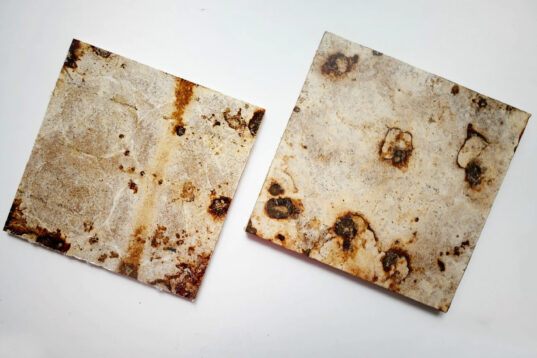
165 projects from 54 universities took part in this year’s competitionline CAMPUS Award. The spectrum of topics ranged from utopias for urban development and material studies to adaptive architecture and after-use strategies. The proportion of projects dealing with sustainable design tasks such as the conversion of existing buildings, climate adaptation in cities or research into alternative materials was particularly high.
In addition to two student award-winning projects, which went to the TU Munich and Leibniz Universität Hannover, and two award-winning final theses from the Kunstakademie Düsseldorf and the University of Stuttgart, one faculty project also received an award.
From nine projects submitted, the jury selected the work “NEWood, a 100% bio-based, sustainable and recyclable material alternative to wood-based products” as the winner. The research by the Institute of Design and Construction Technology at the Karlsruhe Institute of Technology resulted in the “development of a new class of bio-based, resource-efficient and CO2-negative materials.” As an alternative to particleboard, MDF and OSB, the boards are made exclusively from wood and agricultural waste. Mushroom mycelium is used as a natural binder, so no synthetic binders are required.
The research project shows that NEWood has comparable properties to wood-based materials such as MDF, OSB and particleboard. The use of mycelium, the structural part of fungi, is a novel bonding method that enables the production of a 100% bio-based and fully recyclable alternative to wood-based materials. The project team, consisting of Dr. Alireza Javadian, Dr. Nazanin Saeidi and Prof. Dirk E. Hebel, is convinced that “NEWood” will be a sustainable alternative to conventional MDF and particleboard and has the potential to initiate a paradigm shift in the way we produce our future building materials in terms of the circular economy without leaving any waste behind.
More information here.
The “Architekturpreis Gebäudeintegrierte Solartechnik 2022” awards projects that provide outstanding impetus for the planning and design of building-integrated solar systems and draw attention to exemplary solutions in sophisticated architecture. According to the jury, the award-winning projects show that the integration of photovoltaic modules and solar thermal collectors can succeed with equally high design and technical ambition.
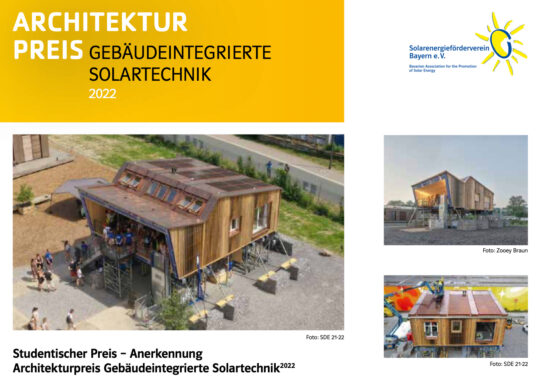
In the RoofKIT project, six high-format standard modules were expanded into photovoltaic-technical hybrid modules. As part of a coherent overall concept, the handling of the PV roof also demonstrates integration into the building design and urban context.
More information here.
In the article “How we build in the future”, the Helmholtz Association presents sustainable, climate-friendly solutions from architecture and construction research. In this context, Prof. Dirk E. Hebel presents the RoofKIT project of the KIT Faculty of Architecture as an innovative lighthouse project for circular justice, purity of types, recycling and reuse, and the resource-friendly handling of materials.
Concrete as a building material is then critically examined. Prof. Frank Dehn, Institute Director at the KIT Civil Engineering Faculty, is researching climate-friendly alternatives and the use of old concrete. In addition, other forward-looking topics such as the “sponge city” and the energy supply of future buildings are highlighted.
Read the full article here.
RoofKIT, the Karlsruhe winning project of the Solar Decathlon 2021/22 was re-located and re-errected in Karlsruhe on Wednesday 09 November 2022. Under the supervision of the project management, the wooden modules were dismantled in Wuppertal within two days, transported to Karlsruhe and now reassembled by the experienced carpenters of Kaufmann Zimmerei und Tischlerei in cooperation with the KIT Solar Decathlon team.
About the project:
The Karlsruhe Institute of Technology participated in the 2021/22 Solar Decathlon Competition in Wuppertal, Germany with its project RoofKIT. Designed as a top-up to an existing structure, it demonstrates a vision for the building industry: social adequate, energy positive and circular sustainable. Since 2020, more than 100 students from KIT within different faculties and under the leadership of the professorships of Sustainable Construction (Prof. Dirk E. Hebel) and Building Technologies (Prof. Andreas Wagner) worked on the project which cumulated in the construction of the House Demonstration Unit in May and June 2022 in Wuppertal, Germany.
For the next three years, the housing unit can be visited on the campus of the Karlsruhe Institute of Technology (Straße am Forum/Richard-Willstädter-Allee). Furthermore, from spring 2023 onwards, research projects subsequent to SDE 21/22 are planned by the Professorship of Building Technology in cooperation with the Professorship of Intelligent Living.
More information about RoofKIT here.
Two members of the RoofKIT team, Katharina Knoop and Johannes Hasselmann, had the opportunity to present the RoofKIT project and the Solar Decathlon at the Ingenieurgruppe Bauen (IGB) in Karlsruhe last Thursday.
All the listeners were very interested in the topics the two presented and were particularly impressed by the team spirit and the continuing enthusiasm and motivation. The event was able to show the company new perspectives for everyday work and planning.
As part of the 17th “Karlsruher Frischpilzausstellung” of the Natural History Museum in Karlsruhe, the MycoTree was exhibited in the pavilion in the Nymphengarten on the 8th and 9th October. The exhibition displayed 250-300 species of mushrooms and presented various literature on mushrooms. The weekend exhibition was visited by almost 1300 people interested in mushrooms.
The MycoTree, a spatial structure made of the cultivated materials mushroom mycelium and bamboo, supplemented the exhibition with the topic area ‘Building materials from natural resources’. At 2 p.m. on both days, Sandra Böhm and Elena Boerman gave a short lecture on the exhibited project, which was created in 2017 as a cooperation project between the KIT Sustainable Building Professorship and the Block Research Group of ETH Zurich.
The assembled elements of the MycoTree can be disassembled again into their original materials and returned to the natural cycle as nutrients. In this way, it shows how digital design, technology and resource-saving materials could come together in the building industry in the future.
How can we build in an environmentally friendly way and redensify city districts in a sensible way? Süddeutsche Zeitung reports about the winning design of the Solar Decathlon 21/22.
The project was supervised by Prof. Dirk E. Hebel and Prof. Andreas Wagner at KIT.
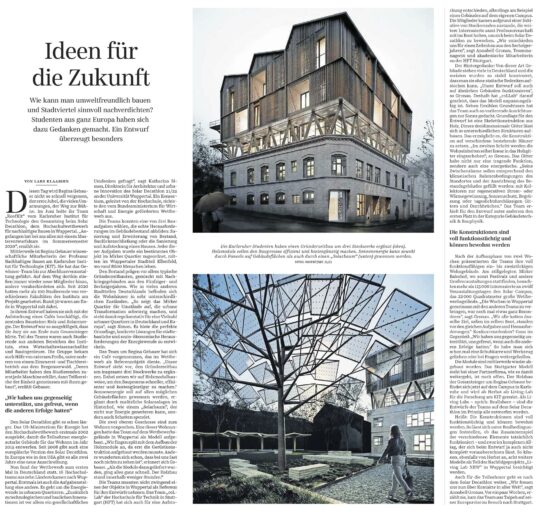
Mushrooms can be used to grow insulations or renewable “bricks”. This could lead to ecologically clean buildings in the future.
Welt am Sonntag reports about scientists like Prof. Dirk E. Hebel working in laboratories on the possibility of replacing metals or mineral materials with harvested materials like mycelium, the root network of mushrooms.
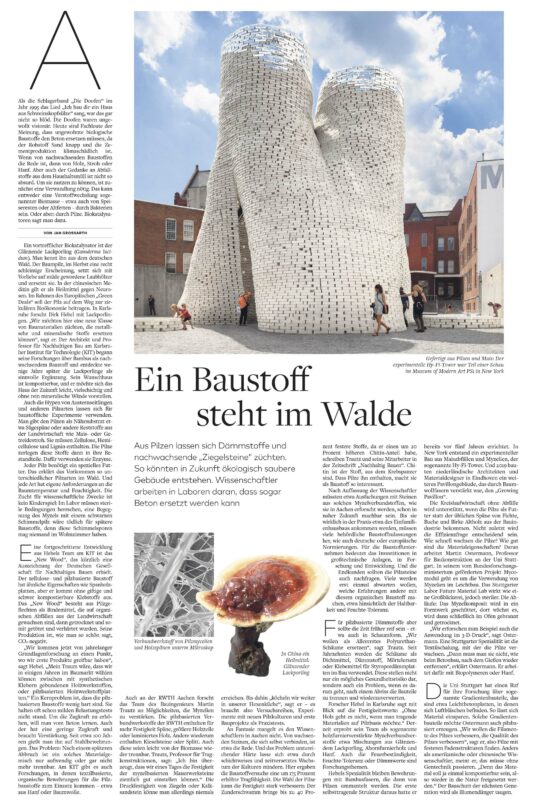
The German Sustainable Building Council (DGNB) announced the winners of this year’s Sustainability Challenge at the DGNB Sustainability Day in Fellbach on 8 July. In the category “Research”, the project “NEWood” lead by Nazanin Saeidi and Alireza Javadian from the Professorship of Sustainable Construction Dirk E. Hebel at KIT in Karlsruhe, came out on top.

Among the start-ups, the jury chose mygreentop. The “Innovation” category was won by Home Power Solutions with picea. The audience award went to the research project “Kalkspeicher” from the German Aerospace Centre (DLR). A total of more than 100 projects and companies entered the DGNB Sustainability Challenge this year.
The selection of the award winners in the DGNB Sustainability Challenge was different this year than in the past. In addition to the finalists, the eleven-member jury also directly determined the winners in the categories “Innovation”, “Start-up” and “Research”.
“The decision was enormously difficult for us as a jury,” says Dr. Christine Lemaitre, Executive Director of the DGNB and part of the selection committee. “All the finalists presented themselves excellently, which is why I can only congratulate them all. They are the best proof that there are smart, forward-thinking people in our industry who can combine sustainability with innovation.”
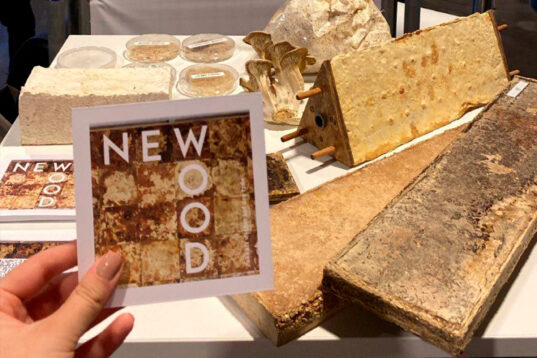
The “NEWood” project is a novel class of bio-based, resource-efficient and CO2-negative materials based on mycelium. Since NEWood shows comparable properties to MDF and chipboard, it serves as a substitute for wood and wood-based materials. The wood alternative is developed exclusively from available organic waste, including wood and agricultural waste, and is manufactured using fungal mycelium as a natural binder.
This year, the jury was made up of Dr Anna Braune (DGNB), Gerhard Breitschaft (Deutsches Institut für Bautechnik), Dominik Campanella (Concular), Prof. Moritz Fleischmann (Düsseldorf University of Applied Sciences), Prof. Andrea Klinge (ZRS Architekten), Dr Christine Lemaitre (DGNB), Martin Prösler (Proesler Kommunikation), Martin Rodeck (EDGE Technologies), Prof. Dr.-Ing. Ing. Anja Rosen (Bergische Universität Wuppertal), Prof. Dr.-Ing. Patrick Teuffel (Eindhoven University of Technology), and Prof. Meike Weber (Hildesheim University of Applied Sciences and Arts).
More information on all award winners and finalists is available online in the DGNB press release or on the DGNB blog. (Text © DGNB)
On Friday 24 June at about 6 pm, the time had finally come – the Competition Director of the Solar Decathlon Europe 2021/22, Karsten Voss, in Wuppertal announced the winning team of the student competition: Team RoofKIT from Karlsruhe! The team was very surprised about this development and expressed their relief, happiness and pride. The moment of the announcement was captured on video by SDE 2021/22:
Second place in the overall competition was taken by Team Virtue from Eindhoven, and third place was shared by Team SUM from Delft and Team Aura from Grenoble. On the website of the SDE 2021/22, all other placements and the intermediate results and awards of the competition can be viewed.
After the award ceremony, Team RoofKIT was visited by WDR and the winning house was shown live on WDR’s Lokalzeit (approx. from minute 20), where some team members were also interviewed about the project.
The Professorship of Sustainable Construction and the Professorship of Building Physics would like to thank all the students and staff of Team RoofKIT and congratulate them on this great competition result!
Our thanks go to the Kaufmann Zimmerei and Tischlerei in Reuthe, Austria and to the Timber Construction Award Jury.
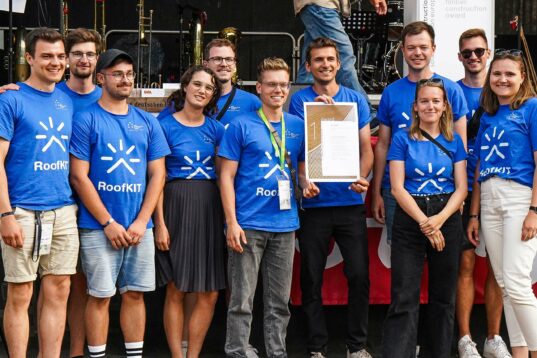
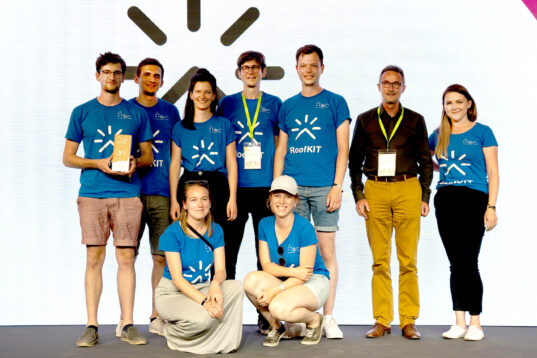
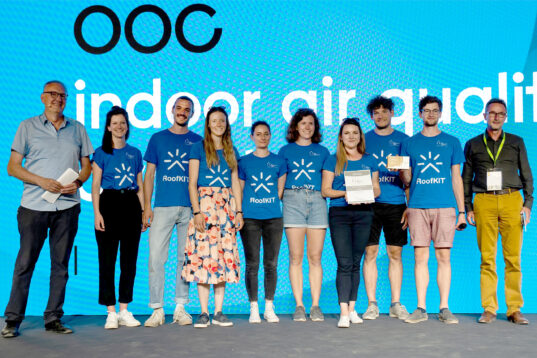
On Sunday 12th the Award Ceremony of the first “Out Of Competition Award” has taken place at the Solar Campus. Team RoofKIT ist very happy that the fist day of Award Ceremonies also brought the first trophy – The inhabitants of the Wuppertal neighborhood of Mirke, where the proposed plots of the SDE 21/22 are located, voted RoofKIT second place of the “Mirke Choice Award”. The team is especially proud that the proposal for topping up the Café ADA in the heart of the neighborhood is appreciated by the people it was designed for.
In order to drive the transformation of the construction and real estate industry towards more sustainability, researchers, young founders and companies are in demand: With the Sustainability Challenge, the DGNB seeks out pioneers who think boldly into the future, question existing systems and initiate new ideas.
In the “Research” category, the project “NEWood – a novel mycelium-based composite made from organic waste” from the KIT Professorship of Sustainable Construction was chosen as one of the three finalists.
The research project is based on three main strategies, which include resource efficiency, circular economy and renewable materials. A new class of bio-based, resource-efficient and CO2-negative materials called “NEWood” has emerged from the project. As NEWood shows comparable properties to MDF (Medium Density Fibre) and chipboard, it serves as a substitute for wood and wood-based materials. The wood alternative is developed exclusively from available organic waste, including wood and agricultural waste, and is produced using fungal mycelium as a natural binder. In cooperation with an industrial partner, the Karlsruhe Institute of Technology team is also exploring the use of digital and advanced manufacturing technologies in the development of mycelium-based composites.
The research project has also been published in Nature as well as in the Sendung mit der Maus and another children’s programme on KIKA.
The public votings for the finalists will be open from 31st May 2022.
Mycelium-bound materials would play a significant role in mitigation of adverse climate change effect imposed by material consumption and resource scarcity. This paper, published by KIT researchers in scientific reports as part Nature publishing group, proposes dense mycelium-based composites (DMCs) as a potential green alternative to traditional particleboards.
Mycelium, as the root of fungi, is composed of filamentous strands of fine hyphae that bind discrete substrate particles into a block material. With advanced processing, dense mycelium-bound composites (DMCs) resembling commercial particleboards can be formed.

In this paper the research team including Dr. Nazanin Saeidi, Dr. Alireza Javadian, and Prof. Dirk E. Hebel from the chair of Sustainable Construction at KIT, Karlsruhe, Germany in collaboration with Urban Biocycle project at FCL global and Xin Ying Chan and Prof. Manoj Gupta from NUS, Singapore have investigated the possibility of using DMCs as a green alternative to particleboards.
A detailed investigation was carried out on the mechanical properties and performance of DMCs under the working conditions of particleboards. The DMC was made using Ganoderma lucidum mycelium grown on a substrate of sawdust and empty fruit bunch collected from the waste byproducts of Sawmills and Palm oil factories. The DMC was then subjected to weathering under tropical conditions over 35 days and tested under flexural, tensile, and compressive loading with reference to international standards. The results over the weathering period reveal that weathering reduces the strength and rigidity of the material.
However, by application of a commonly used natural oil-based coating DMC was able to withstand degradation under tropical weathering conditions. Furthermore, it was shown that some improvements to the material’s consistency could effectively increase the material strength and resistance to weathering with the help of a protective coating. Therefore, DMC could be a promising material as an environmentally friendly substitute for particleboards if such improvements in material production are made.
More information about the scientific report on nature.com.
The Green Solutions Awards ceremony took place in Glasgow on Wednesday 10 November 2021. The competition, organised by the international Construction21 platform, rewards outstanding architectural projects that address the challenges of climate protection and sustainability in an innovative way. Winners were selected from 192 entries from 25 countries in eight categories. 16 other projects received recognition from the jury, which is made up of experts in sustainable construction from around the world.
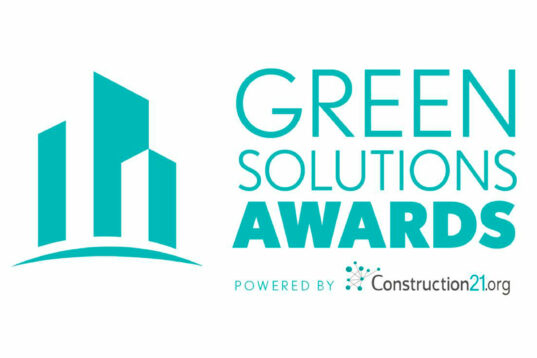
The jury was particularly impressed by these projects because they address the key issues of sustainable construction: economy of materials, energy efficiency, health and user comfort, off-site prefabrication, protection of biodiversity and species, circular economy, and many more. They were also selected because they have the potential to inspire building sector professionals and be adapted and developed on a large scale.


The Mehr.WERT.Pavillon – Top View © Jonathan Preker Copterbrothers, Side view © Felix Heisel
The Mehr.WERT.Pavillon, built up on the Bundesgartenschau 2019 in Heilbronn, was awarded the Sustainable Infrastructure Grand Prize. The building proved that it is already possible today to design and realise sophisticated architecture entirely from the materials of the urban mine, and to apply the principles of the circular economy in its construction without compromise. The materials used for the construction were all selected according to these requirements and joined only with the help of detachable, mechanical connections, so that they can be completely reused or recycled without any loss of value. However, the structure was so convincing that it has now been completely relocated for the time being after the end of the exhibition and will continue to exist for a few more years near its original location – as a material storage facility, social meeting place and physical proof that it is already possible to build in a cycle-friendly manner today.
The jury of the Green Solutions Awards 2020-21 stated: “By betting on the circular economy, it shows how urban areas can be sources of materials. The Mehr Wert Pavilion in Germany is built entirely from recycled materials and can be completely dismantled. A feat in terms of sobriety that should send a signal to all planners and builders.”
The aim of the pavilion was and is to discuss important questions of future building and the associated use of resources with decision-makers from politics, building planning and implementation, and to develop new innovative concepts, applications and methods from this, both in practice and in teaching.
The Ministry for the Environment, Climate Protection and Energy Sector Baden Württemberg has produced a film about the development process of the Mehr.WERT.Pavilion from planning to construction, which can be viewed here.
How do we want to live in the future? And how can we also be sure in the future that there will be enough raw materials to provide everything needed in daily life? Clari, Jana, Ralph and André from the “Sendung mit der Maus” are looking into securing raw materials and urban mining.
For this purpose, they are opening a future flat-sharing community for four weeks in the Urban Mining and Recycling Unit in the NEST research building on the EMPA campus in Dübendorf, and from there they are exploring where and how the various components of the research unit were produced.
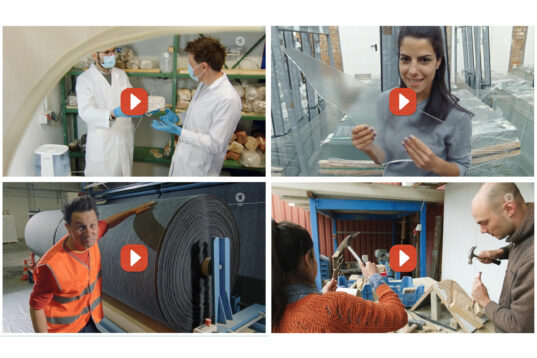
The first part is about the recycling of bricks into new masonry units. The focus is also on the MycoLab of the KIT in Karlsruhe and the production of insulating material from mycelium there. The second episode shows the viewers the production process of glass ceramics and plate material from melted plastic. The third episode deals with the production of table tops from used beverage cartons and with recyclable carpets. The fourth episode focuses on technical innovations and the deconstruction of materials from urban mining.
The four-part series “Urban Mining” from the “Sendung mit der Maus” conveys an understanding of the responsible use of our raw materials in a child-friendly way.
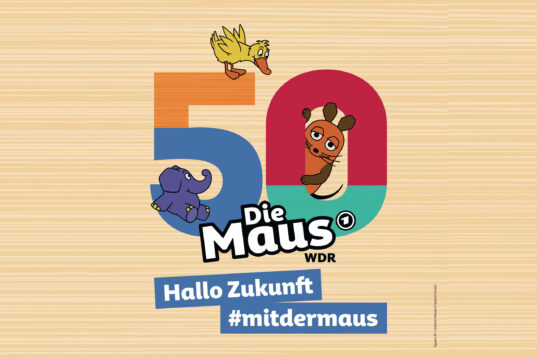
At the “Door opener day with the mouse”, the 3 October 2021, upcoming ideas, innovative plannings, exciting projects and much more will be presented to children under the motto “Hello Future” all over Germany. One of the numerous participatory activities will take place at the KIT in Karlsruhe.
At the MycoLab at KIT, the Professorship of Sustainable Construction at the Faculty of Architecture, Prof. Dirk Hebel, is conducting research on alternative building materials. The team is working on the conversion of organic waste into alternative, cultivated and biological building materials. This involves the use of mycelium, the route of mushrooms, which is fed with biological waste so that stable, pressure-resistant forms can subsequently be realized.
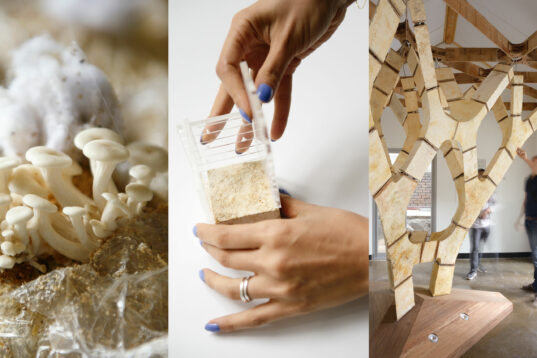
The MycoLab has already been featured by ZDF PUR+ last year, and in the program “Sendung mit der Maus” on its 50th anniversary a few months ago.
On the “Door opener day” the MycoLab team aims to show the participating children how alternative sustainable resources can be regrown faster than wood without any negative impacts on our forests and biodiversity as well as our climate by utilizing the wood and agricultural waste resources and turning them into sustainable, biobased and green building materials with the power of mushrooms.
To join the event, please registrate here.
On the occasion of the 50th birthday of “Die Maus”, numerous special episodes are being filmed this year. In this context, “Die Sendung mit der Maus” also visited the Urban Mining and Recycling (UMAR) housing and research unit of the Swiss research institute Empa at “NEST” in Dübendorf near Zurich in Switzerland.

In the middle of June, NEST Innovation Manager Enrico Marchesi invited Prof. Dirk E. Hebel and Sandra Böhm from the Professorship of Sustainable Construction to present the housing unit, the building materials used there, and the construction and material concept to the viewers of the “Sendung mit der Maus” after a brief welcome. The Urban Mining and Recycling Unit of the EMPA is still one of a few lighthouse projects of circular construction. Many innovative, forward-looking construction techniques are used in exemplary applications, which allow the sorted disassembly and the later reuse of all used materials. The unit was created in 2017 by Werner Sobek with Dirk E. Hebel and Felix Heisel, Bernd Köhler and Frank Heinlein.
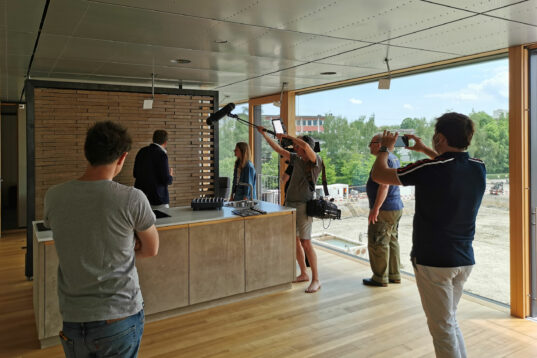
Ralph, Jana, Sihan, André from “Die Sendung mit der Maus”, Prof. Dirk E. Hebel, Sandra Böhm and Enrico Marchesi were present for the filming session in the Urban Mining and Recycling Unit at NEST at EMPA in Dübendorf, Switzerland. The programme will be broadcast as a special episode as part of the Mouse’s 50th birthday events in August 2021.
More information about the 50th birthday of “Die Maus” here.
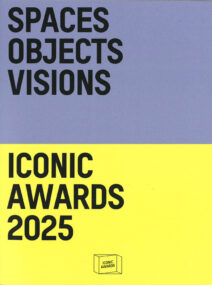
Dietzold, Lutz, ed. Iconic Awards 2025 – Spaces Objects Visions. Frankfurt: Rat für Formgebung GmbH, 2025.
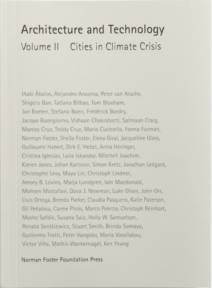
Hebel, Dirk E. “Activating the Urban Mine.“ In Architecture and Technology Volume II: Cities in Climate Crisis. Madrid: Norman Foster Foundation Press, 2025.

Hebel, Dirk E. und Felix Heisel. “Die Stadt als Ressource.” In Für eine nachhaltige Architektur der Stadt. Berlin: Verlag Klaus Wagenbach, 2025.
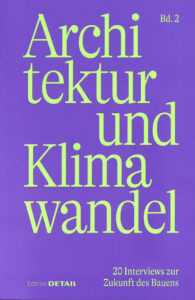
Hebel, Dirk E. “Vom Linearen Zum Kreislaufsystem.” In Architektur Und Klimawandel. München: Edition DETAIL, 2025.
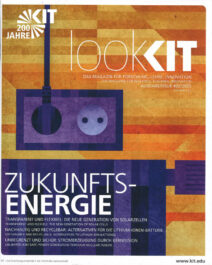
Hebel, Dirk E. Interview: “Wir müssen endlich anfangen, den CO2-Ausstoß zu messen – nicht nur, wie dick die Dämmung ist.” Interview by Christoph Karcher. LooKIT 0225, 2025.
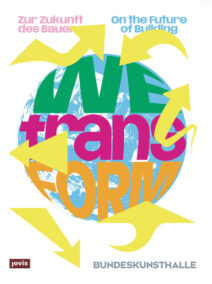
BUNDESKUNSTHALLE, ed. WEtransFORM – Zur Zukunft Des Bauens. Berlin: jovis Verlag, 2025.
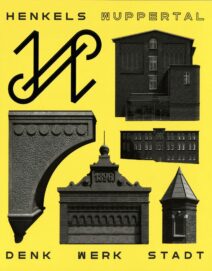
Renaissance AG, ed. Henkels Wuppertal – DenkWerkStadt. Wuppertal: renaissance Immobilien und Beteiligungen Aktiengesellschaft, 2025.
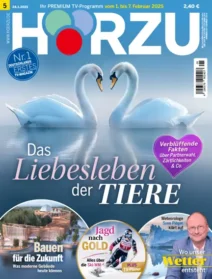
Monkenbusch, Helmut. „Bauen für die Welt von morgen.“ Hörzu, 24.1.2025
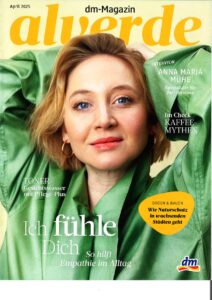
Hebel, Dirk E., Tanja Hildbrandt. „ Pilze – Netzwerker im Untergrund“. alverde, dm-Magazin, April 2025.
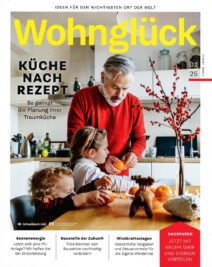
Merkert-Andreas, Carolin. “Pilze Sind Vielseitig.” Wohnglück, January 2025.
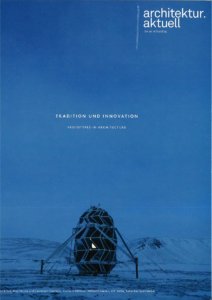
Boerman, Elena, and Dirk E. Hebel. “RoofKIT – Kohlenstoffspeicher Und Materiallager.” Architektur.Aktuell, vol. 12.2024, no. Tradition und Innovation, Dezember 2024, pp. 98–109

Hebel, Dirk E. Interview: “Vom linearen zum zirkulären Kreislaufsystem.” Interview by Sandra Hofmeister, DETAIL 11.2024, Nov. 2024.

Hebel, Dirk E., Sandra Böhm, Elena Boerman, Hrsg. Vom Bauen mit erneuerbaren Materialien – Die Natur als Rohstofflager. Stuttgart: Fraunhofer IRB Verlag, 2024.
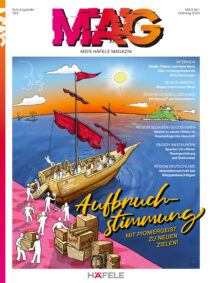
Hebel, Dirk E. “In Kreisläufen denken, entwerfen und wirtschaften.” MÄG – Mein Häfele Magazin, 2024.
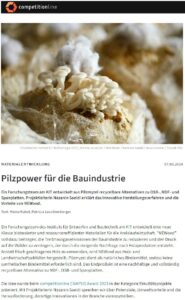
Rubel, Maike, and Patricia Leuchtenberger. Interview: “Pilzpower für die Bauindustrie.” competitionline, 7 June 2024, https://www.competitionline.com/de/news/schwerpunkt/pilzpower-fuer-die-bauindustrie-7283.html.

Müller, Janek. “Baumaterialien der Zukunft: Pilze, Hanf und Algen.” neubau kompass – Neubauprojekte in Deutschland, May 3, 2024. https://www.neubaukompass.de/premium-magazin/.
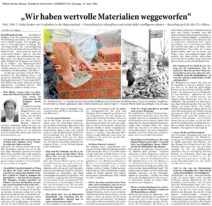
Sören, S. Sgries. “Interview: ‘Wir haben wertvolle Materialien weggeworfen.’” Rhein-Neckar-Zeitung, April 27, 2024, SÜDWEST I 28 edition, sec. Sinsheimer Nachrichten.

Schweikle, Johannes. “Auf Pilz gebaut.” Stuttgarter Zeitung, April 23, 2024, sec. Die Reportage.
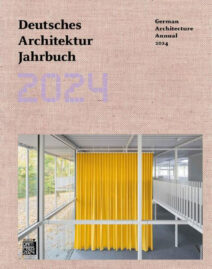
Klaaßen, Lars. “Organische Architektur – Pilzmyzel und Flachs als Materialien für die ökologische Bauwende.” In Deutsches Architektur Jahrbuch 2024, edited by Peter Cachola Schmal, Yorck Förster, and Christina Gräwe, 198–209. Berlin, Germany: DOM publishers, 2024.
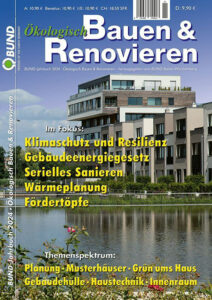
Streiff, Peter. “Zirkuläres Bauen – Kreislauf statt Abriss.” BUND-Jahrbuch – Ökologisch Bauen & Renovieren 2024, January 2024.
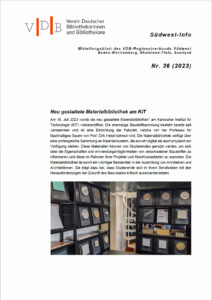
Mönnich, Michael, and Sandra Böhm. “Neu gestaltete Materialbibliothek am KIT.” Südwest-Info: Mitteilungsblatt des VDB-Regionalverbands Südwest Nr. 36 (2023), 2023.
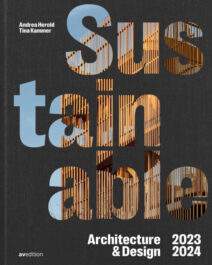
Hebel, Dirk E. “RoofKIT Wuppertal, Germany; Interview with Prof. Dirk Hebel: The aim is clear, we must forge the path ourselves.” In Sustainable Architecture & Design 2023/ 2024, edited by Andrea Herold, Tina Kammerer, and InteriorPark., 46–55. Stuttgart, Germany: av edition GmbH, 2023.
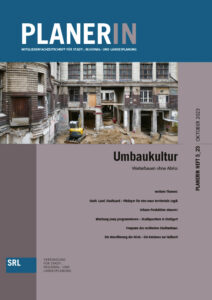
Hebel, Dirk E. “Der Bestand ist die künftige Ressource – Den linearen Umgang mit Baumaterialien schnellstmöglich stoppen.” Planerin – Mitgliederfachzeitschrift für Stadt-, Regional- und Landesplanung, Oktober 2023.
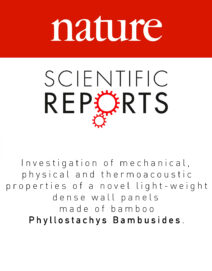
Gholizadeh, Parham, Hamid Zarea Hosseinabadi, Dirk E. Hebel, and Alireza Javadian. “Investigation of Mechanical, Physical and Thermoacoustic Properties of a Novel Light-Weight Dense Wall Panels Made of Bamboo Phyllostachys Bambusides.” Nature Sientific Reports 13 (October 26, 2023). https://doi.org/https://doi.org/10.1038/s41598-023-45515-3
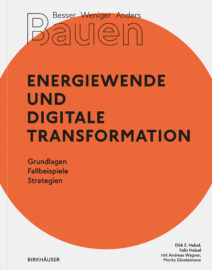
Hebel, Dirk E., Felix Heisel, Andreas Wagner, und Moritz Dörstelmann, Hrsg. Besser Weniger Anders Bauen – Energiewende und digitale Transformation. Besser Weniger Anders Bauen 2. Basel: Birkhäuser Verlag GmbH, 2023.
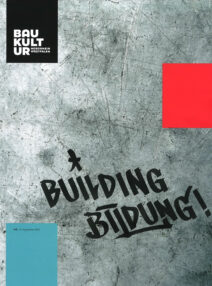
Hebel, Dirk E. “Vom Jagen, Züchten Und Ernten Zukünftiger Baumaterialien.” Baukultur Nordrhein Westfalen, September 2023.
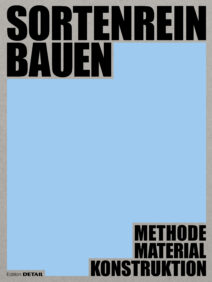
Hebel, Dirk E., Ludwig Wappner, Katharina Blümke, Valerio Calavetta, Steffen Bytomski, Lisa Häberle, Peter Hoffmann, Paula Holtmann, Hanna Hoss, Daniel Lenz and Falk Schneemann, eds. Sortenrein Bauen – Methode Material Konstruktion. Edition DETAIL. München: DETAIL Business Information GmbH, 2023.
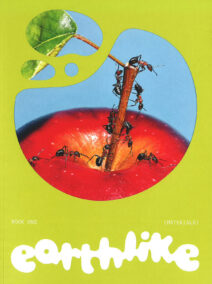
Schweikle, Johannes. “Fungi.” In Earthlike, 1:70–75, 2023.
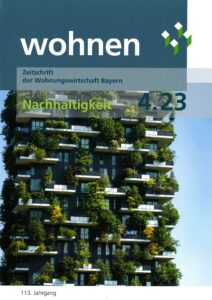
Hebel, Dirk E. “Die Stadt als Rohstofflager.” wohnen – Zeitschrift der Wohnungswirtschaft Bayern, August 2023.
Hebel, Dirk E. “Das RoofKIT-Gebäude der KIT Fakultät für Architektur – Gewinner des Solar Decathlon 2021/22 in Wuppertal.” wohnen – Zeitschrift der Wohnungswirtschaft Bayern, August 2023.
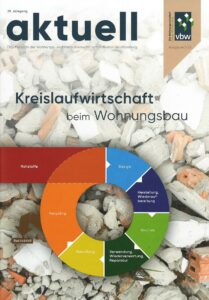
Hebel, Dirk E. “Die Stadt Als Rohstofflager.” Aktuell – Das Magazin Der Wohnung- Und Immobilienwirtschaft in Baden-Württemberg, 2023.